In Brazil, dengue viruses are transmitted by the female Aedes aegypti mosquito.
Dengue fever is an acute febrile infectious disease caused by a virus belonging to the family Flaviviridae, of the genus Flavivirus. Dengue virus has four serotypes generally called DENV-1, DENV-2, DENV-3, and DENV-4. These are also classified as lobed viruses, that is, they are usually transmitted by mosquitoes. In Brazil, dengue viruses are transmitted by the female Aedes aegypti mosquito and can cause both the classic manifestation of the disease and the hemorrhagic form.
Continue after advertisement
Aedes aegypti has been described as an insect with strict urban behaviour, and it is rare to find specimens of its eggs or larvae in forest water tanks. Since the vector is in the disease transmission cycle, any dengue epidemic is directly related to the concentration of mosquito density, that is, the higher the number of insects, the more likely it will occur.
The eggs are placed in containers such as cans and empty bottles, tires, gutters, exposed water tanks, potted plants, or anything else that can store rainwater. In a period of five to seven days, the larva goes through four stages until a new mosquito is born.
Continue after advertisement
Aedes aegypti females usually live indoors in dark, low environments (under tables, chairs, cupboards, etc.), where they can find temperatures (ranging from 24 to 28 °C) and humidity suitable for adult mosquitoes. They feed on plant sap and bite humans in search of blood to ripen their eggs. On average, each mosquito lives about 30 days and the female lays between 150 and 200 eggs per egg-laying cycle, which takes 4 to 5 days. Once infected with the dengue virus, after an incubation period of 8 to 12 days, the female becomes a permanent carrier of the disease.
Studies show that the best chance of encountering A. aegyptise occurs in the aquatic phase (larva and pupae), especially with the places where the female lays eggs removed or closed. Another possibility of control is related to the use of insecticides. However, evidence indicates that the vector’s natural populations are indeed resistant, demonstrating the limited power of this strategy.
As a mechanism of individual protection, homemade insect repellents and insecticides can be used following the recommendations on the package or medical advice in the case of children and sensitive people. In this sense, the most effective method of vector control is awareness and constant monitoring of the outbreak in the home by the entire population. In addition, it is necessary to constantly monitor vacant plots, abandoned houses and any other places that can serve as potential hotbeds of mosquito breeding.
Symptoms / Diagnosis
The disease can be asymptomatic or it can develop into more serious conditions, such as bleeding and shock. In so-called classic dengue fever, which must be reported, the first manifestation is a high fever (39° to 40°C) and sudden onset, usually followed by headache or eye pain, fatigue, or muscle and bone pain, and decreased In appetite, nausea, dizziness, vomiting, rash (similar to rubella). The disease lasts from five to seven days (maximum 10 days), but the recovery period may be accompanied by significant physical weakness and may last for several weeks.
With regard to the most severe form of the disease, known as dengue hemorrhagic fever, the initial symptoms are similar, but the condition worsens on the third or fourth day of development, with the appearance of hemorrhagic manifestations and the collapse of blood circulation. In severe cases, shock usually occurs between the third and seventh day of illness, and is usually preceded by abdominal pain.
Regarding immunity to the virus, some studies suggest that when a person is infected with one of the four serotypes, they become immune to all types of viruses for a few months and then remain immune to that type for the rest of their life. injured. If you catch dengue again, this time one of the three other types of virus you wouldn’t have, it may or may not have a more serious form. It is important to note the presence of warning signs (persistent vomiting, abdominal pain, postural hypotension, bleeding and insomnia), and in the presence of these signs, seek medical attention immediately.
According to Rodrigo Rodriguez, a biochemist at Sandrini’s laboratory, laboratory diagnosis of dengue fever can be made using serological methods, indicated at different times of the disease. The NS1 antigen test should be performed within the first five days of symptom onset, as it is a glycoprotein found on the surface of the virus. The search for antibodies to IgM and IgG classes in the blood was already detected from the sixth day of the primary infection.
Treatment / Prevention
To date, there is no effective treatment against the dengue virus. However, treatment is based on analgesics and antipyretics and can be performed at home, with guidance to return to the health service. Moisturizing the mouth is indicated with increased intake of water, juices, teas, homemade serums, etc. Medicines containing acetylsalicylic acid (ASA) or its derivatives should not be used because they increase the risk of bleeding. With regard to dengue hemorrhagic fever, treatment is carried out from hospitalization of the patient.

“Wannabe internet buff. Future teen idol. Hardcore zombie guru. Gamer. Avid creator. Entrepreneur. Bacon ninja.”



